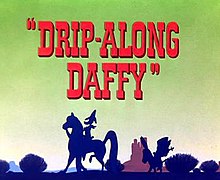| Drip-Along Daffy | |
|---|---|
 Title card | |
| Directed by | Charles M. Jones |
| Story by | Michael Maltese |
| Starring | Mel Blanc |
| Music by | Carl Stalling |
| Animation by | Phil Monroe Lloyd Vaughan Ben Washam Ken Harris |
| Layouts by | Philip DeGuard |
| Backgrounds by | Robert Gribbroek[1] |
| Color process | Color by: Technicolor |
Production company | |
| Distributed by | Warner Bros. Pictures The Vitaphone Corporation |
Release date |
|
Running time | 7:20 |
| Language | English |
Drip-Along Daffy is a 1951 Warner Bros. Merrie Melodies theatrical cartoon short, directed by Chuck Jones and written by Michael Maltese.[2] The cartoon was released on November 17, 1951, and stars Daffy Duck and Porky Pig.[3]
This cartoon was produced as a parody of Westerns which were popular at the time of its release, and features Daffy Duck as a "Western-Type Hero", who, with his trusty "Comedy Relief" (Porky Pig) hopes to clean up a violence-filled "one-horse town". In a tongue-in-cheek nod to The Lone Ranger, Daffy's horse is named "Tinfoil". The cartoon includes an original song (sung by Porky) called "The Flower of Gower Gulch", a parody of sentimental cowboy-style love songs, Gower Gulch being an intersection in Hollywood known as a gathering spot for would-be actors in early Westerns.[4]
Drip-Along Daffy featured the first appearance of the villain character Nasty Canasta, a Mexican rogue who would resurface in several later Jones cartoons, as well as an episode of The Sylvester and Tweety Mysteries, the movie Looney Tunes: Back in Action in 2003, and occasionally on the Duck Dodgers TV series.
- ^ "Drip-Along Daffy[dead link]". Big Cartoon DataBase, June 3, 2016
- ^ Beck, Jerry; Friedwald, Will (1989). Looney Tunes and Merrie Melodies: A Complete Illustrated Guide to the Warner Bros. Cartoons. Henry Holt and Co. p. 228. ISBN 0-8050-0894-2.
- ^ Lenburg, Jeff (1999). The Encyclopedia of Animated Cartoons. Checkmark Books. pp. 70–72. ISBN 0-8160-3831-7. Retrieved 6 June 2020.
- ^ "Gower Gulch" was the nickname of the intersection of Gower Street and Sunset Boulevard. Paramount and RKO studios had lots on Gower Street, so aspiring actors and actresses would gather there in numbers, hoping to be cast for a part in a Western. See: Zelda Cini and Bob Crane, with Peter H. Brown, Hollywood: Land and Legend (Westport, Connecticut: Arlington House, 1980), pages 18 and 71.